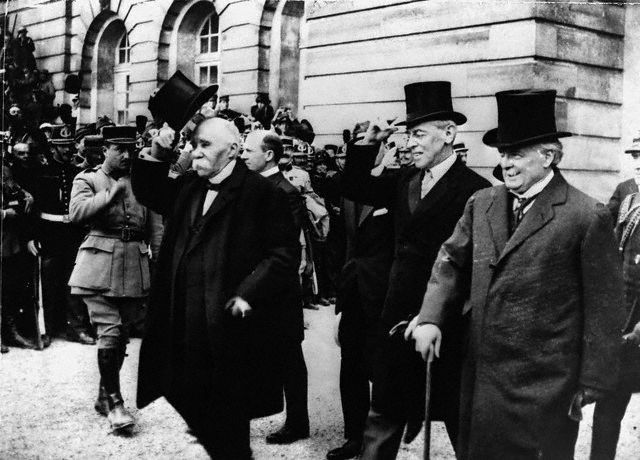The Paris Peace Conference
- 18thJanuary 1919 -
Two months after the official Armistice on 11th November 1918 the matter of how to settle the outstanding issues was hotly debated in Paris. This conference was to result in the Treaty of Versailles that was signed in the Hall of Mirrors, Palace of Versailles, on 28thJune 1919. However, the longer term ramifications were to be felt again in 1939 when another global broke out – World War Two. In a quirk of fate the treaty was signed five years to the day that a bullet killed Archduke Franz Ferdinand in Sarajevo – an event that escalated to the Great War.
 There were 30 nations represented at the conference but very quickly a ‘Big Three’ were established – the USA, UK and France – with Italy clambering to make it a ‘Big Four’. Woodrow Wilson was the President of America and his objectives contrasted markedly with those of the French President, Clemenceau, and the British PM, Lloyd George. The US had not entered the war until April 1917 and were not bound by the same ties as their European counterparts. Wilson did not want to throttle the life out of Germany and was more interested in establishing a League of Nations – the forerunner to the United Nations – as a way of ensuring future peace and acting as judge in the international community. The French and British demanded punitive measures against Germany to make the pay – literally – for everything that had happened. Nor did they want a League of Nations – preferring to police Europe themselves.
There were 30 nations represented at the conference but very quickly a ‘Big Three’ were established – the USA, UK and France – with Italy clambering to make it a ‘Big Four’. Woodrow Wilson was the President of America and his objectives contrasted markedly with those of the French President, Clemenceau, and the British PM, Lloyd George. The US had not entered the war until April 1917 and were not bound by the same ties as their European counterparts. Wilson did not want to throttle the life out of Germany and was more interested in establishing a League of Nations – the forerunner to the United Nations – as a way of ensuring future peace and acting as judge in the international community. The French and British demanded punitive measures against Germany to make the pay – literally – for everything that had happened. Nor did they want a League of Nations – preferring to police Europe themselves.
What was also crucial were those countries who were absent. Russia had withdrawn from the war after the Bolshevik Revolution in 1917. The new communist government repudiated any money that was owed to the Allies. The West refused to recognise the government as legal and refused to invite them. Germany, and the other Axis powers, Austria-Hungary, Turkey and Bulgaria were also denied a place at the meeting.
By the end of the meeting a compromise of sorts was reached. The German Army and Navy were severely limited in size, 10% of Germany’s land was re-distributed and key industrial sites, and natural resources were placed under neutral control and Allied troops would occupy the Rhineland. Germany were also to pay 32 billion US dollars in reparations and made to accept complete responsibility for the war. A League of Nations was established. Wilson was against the massive money Germany was expected to pay and vehemently opposed to article 231 of the treaty that Germany accepted sole blame.
There was a huge resentment and anger in Germany at the harsh terms it was forced to accept. This led to a growth in extremist politics in that country and the rise of parties such as Hitler’s Nationalist Socialist (Nazi) Party and they capitalised on the emotions of the nation to come to power in the 1930s with the mission to re-build Germany into a powerful country again. The Treaty of Versailles and the lack of a longer term vision by key politicians was to allow a climate to build that allowed this type of nationalist politics to flourish and lead directly to World War 2. The War that was supposed to end all wars led directly to another and the losers were the people of the world – let own by their elected leaders.


